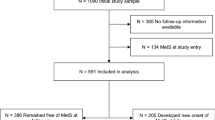Abstract
Objective: To describe food habits and dietary intakes of athletic and non-athletic adolescents in Switzerland.
Setting: College, high schools and professional centers in the Swiss canton of Vaud.
Method: A total of 3540 subjects aged 9–19 y answered a self-reported anonymous questionnaire to assess lifestyles, physical plus sports activity and food habits. Within this sample, a subgroup of 246 subjects aged 11–15 also participated in an in-depth ancillary study including a 3 day dietary record completed by an interview with a dietician.
Results: More boys than girls reported engaging in regular sports activities (P<0.001). Adolescent food habits are quite traditional: up to 15 y, most of the respondents have a breakfast and eat at least two hot meals a day, the percentages decreasing thereafter. Snacking is widespread among adolescents (60–80% in the morning, 80–90% in the afternoon). Food habits among athletic adolescents are healthier and also are perceived as such in a higher proportion. Among athletic adolescents, consumption frequency is higher for dairy products and ready to eat (RTE) cereals, for fruit, fruit juices and salad (P<0.05 at least). Thus the athletic adolescent’s food brings more micronutrients than the diet of their non-athletic counterparts. Within the subgroup (ancillary study), mean energy intake corresponds to requirements for age/gender group.
Conclusions: Athletic adolescents display healthier food habits than non-athletic adolescents: this result supports the idea that healthy behavior tends to cluster and suggests that prevention programs among this age group should target simultaneously both sports activity and food habits.
Sponsorship: Service of Sports and Physical Education of the Swiss canton of Vaud, Federal Sports School of Macolin (Switzerland).
European Journal of Clinical Nutrition (2000) 54, Suppl 1, S16–S20
This is a preview of subscription content, access via your institution
Access options
Subscribe to this journal
Receive 12 print issues and online access
$259.00 per year
only $21.58 per issue
Buy this article
- Purchase on Springer Link
- Instant access to full article PDF
Prices may be subject to local taxes which are calculated during checkout
Similar content being viewed by others
Author information
Authors and Affiliations
Contributions
Guarantor: C Cavadini.
Contributors: CC was the designer and main investigator of the nutritional survey, responsible for fieldwork and for data analysis. BD designed the nutritional survey and was involved in fieldwork and data analysis. JG was involved in fieldwork and data analysis of the nutritional survey. FN designed the main study, and carried out data analysis. P-AM was director of and designed the main study, and was the main investigator.
Corresponding author
Rights and permissions
About this article
Cite this article
Cavadini, C., Decarli, B., Grin, J. et al. Food habits and sport activity during adolescence: differences between athletic and non-athletic teenagers in Switzerland. Eur J Clin Nutr 54 (Suppl 1), S16–S20 (2000). https://doi.org/10.1038/sj.ejcn.1600979
Published:
Issue Date:
DOI: https://doi.org/10.1038/sj.ejcn.1600979
Keywords
This article is cited by
-
The mediating effect of food choice upon associations between adolescent health-related quality of life and physical activity, social media use and abstinence from alcohol
Health and Quality of Life Outcomes (2023)
-
Sports drink consumption and diet of children involved in organized sport
Journal of the International Society of Sports Nutrition (2013)
-
Körperliche Aktivität
Ernährung - Wissenschaft und Praxis (2008)
-
Körperliche Aktivität
Monatsschrift Kinderheilkunde (2008)
-
Daily calcium intake in male children and adolescents obtained from the rapid assessment method and the 24-hour recall method
Nutrition Journal (2007)



